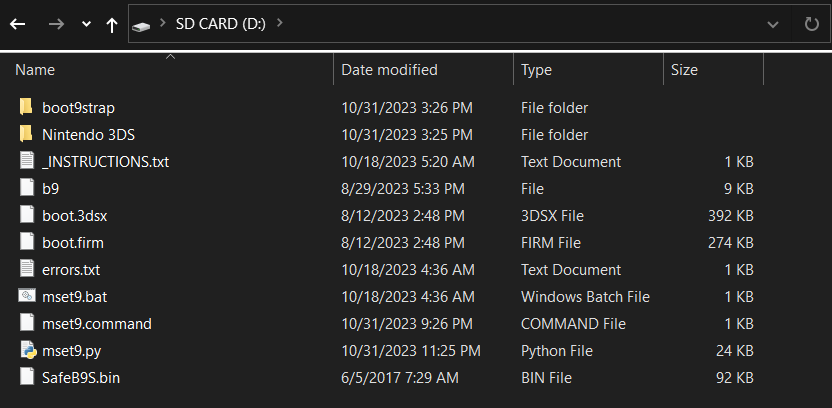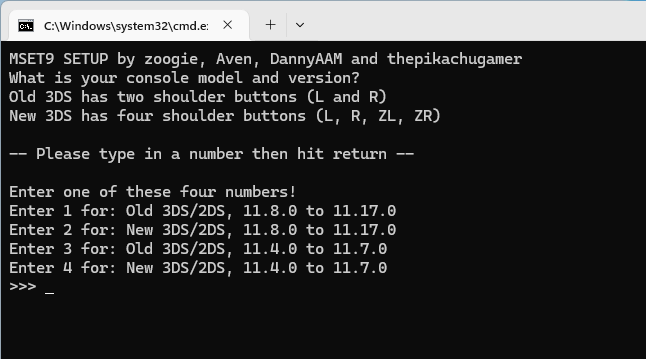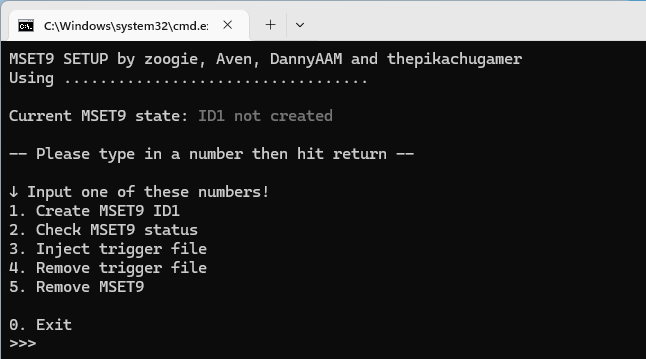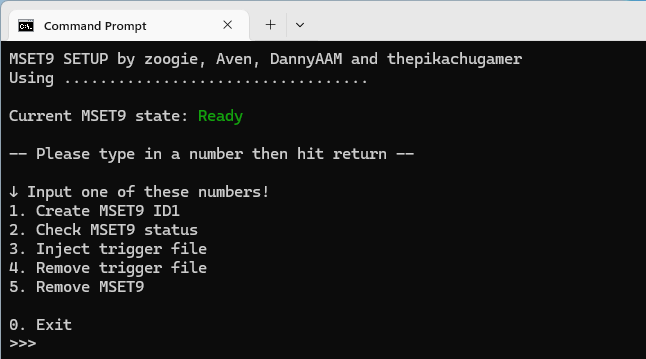Installing boot9strap (MSET9 CLI)
Technical Details (optional)
MSET9 is an exploit for the System Settings application developed by zoogie. It exploits a flaw where the ID1 (the second 32-character folder name inside of the Nintendo 3DS folder, inside of the ID0) can be any name as long as it is 32 characters. Performing a specific sequence of actions results in the console executing the instructions that are encoded into the ID1 folder name, which can be used to grant full control over the console.
Compatibility Notes
WARNING
This page requires a computer running Windows, Linux, or macOS. If you have an Android phone/tablet or a Chromebook, follow Installing boot9strap (MSET9 Play Store) instead. If you have an iPhone or iPad, follow Installing boot9strap (MSET9 CLI iOS) instead. If you do not have access to any of these devices, you will need to use an alternate exploit.
INFO
If you are using an Android device as an SD card adapter for your computer, you will not be able to follow this page due to incompatibilities with Android's file transfer protocol (MTP). If this is the case, follow Installing boot9strap (MSET9 Play Store) instead.
What You Need
- The latest release of MSET9 (the MSET9
.zipfile) - Any 3.x version of Python installed on your computer
- If you are on Windows, Python from the Microsoft Store cannot be used. Please install a version from python.org.
- If you are on Linux or macOS, you may already have Python 3. Check by opening a Terminal window and entering
python3 -V. If this returns a version number, it will work for this guide.
Instructions
INFO
On this page, you will use the MSET9 script, which is used to trigger MSET9. While the script is in progress, user data will temporarily disappear but will return upon the completion of this page. If you get an error when running the script, the solution to that error can most likely be found on the troubleshooting page.
Section I - Prep Work
In this section, you will prepare the MSET9 exploit by temporarily creating a new HOME Menu profile with almost no user data, and then setting up that profile with only the minimum data required for MSET9 to trigger. Your existing user data will disappear, but will come back when you are finished with this page.
Insert your SD card into your computer
Copy everything from the MSET9
.zipto the root of your SD card. If any of the files exist, overwrite them with the new files.INFO

Run the MSET9 script:
- Windows: Double-click
MSET9-Windows.bat - macOS: Double-click
MSET9-macOS.commandand enter your password if prompted - Linux: open a Terminal window,
cdto the root of your SD card, then typepython3 mset9.pyand press Enter
INFO

- Windows: Double-click
Type the number corresponding to your console model and version, then press Enter
- The window should change to this:
INFO

- Ensure that the correct console model and version is displayed
Type
1, then press Enter to begin the process of creating the MSET9 ID1After reviewing the disclaimer, type
1again and press Enter to accept it- If you get an error, check the troubleshooting, then try again
If you see the message "Created hacked ID1.", press Enter to close the MSET9 script
- Your console will appear to lose most data / no user-installed apps on HOME Menu. This is expected. Your data will come back at a later step
Reinsert your SD card into your console
Power on your console
Open Mii Maker
Wait for your console to reach the Welcome to Mii Maker screen, then exit Mii Maker and return to the HOME Menu
- You may see this screen, which indicates the necessary data has been created
- If you just reach the normal Mii Maker screen, then the data already exists. Exit Mii Maker and return to the HOME Menu
Launch System Settings and navigate to
Data Management->Nintendo 3DS->Software-> Reset (image)- This will not wipe any of your data
Power off your console by pressing the power button then tapping Power Off on the lower screen
Insert your SD card into your computer
Run the MSET9 script:
- Windows: Double-click
MSET9-Windows.bat - macOS: Double-click
MSET9-macOS.commandand enter your password if prompted - Linux: open a Terminal window,
cdto the root of your SD card, then typepython3 mset9.pyand press Enter
- Windows: Double-click
Type the number corresponding to your console model and version, then press Enter
- The window should change to this and display
Ready:
INFO

- If the window says Not ready - check MSET9 status for more details:
- Type
2, then press Enter to check the MSET9 status and follow the directions indicated - Once you have resolved the issue, return to Section I Step 14
- For more information, check the troubleshooting page
- Type
- The window should change to this and display
Type
0, then press Enter to close the scriptReinsert your SD card into your console
Section II - MSET9
In this section, you will trigger MSET9 to launch SafeB9SInstaller (the custom firmware installer).
DANGER
These instructions must be followed EXACTLY, so double-check EVERYTHING you are doing to avoid errors!
- Power on your console, ensuring System Settings is selected
- If System Settings is not selected, hover over the System Settings icon using the D-Pad, power your console off, then back on
- Press (A) to launch System Settings
- Navigate to
Data Management->Nintendo 3DS->Extra Data(image) - Do not press any buttons or touch the screen
- With the console STILL ON, and without pressing any buttons or touching the screen, remove your SD card from your console
- The menu will refresh and say that no SD card is inserted, which is expected
- Insert your SD card into your computer
- Run the MSET9 script:
- Windows: Double-click
MSET9-Windows.bat - macOS: Double-click
MSET9-macOS.commandand enter your password if prompted - Linux: open a Terminal window,
cdto the root of your SD card, then typepython3 mset9.pyand press Enter
- Windows: Double-click
- Type the number corresponding to your console model and version, then press Enter
- In the MSET9 window, type
3, then press Enter to inject MSET9- You should see "MSET9 successfully injected!"
- Press Enter to close the MSET9 script
- Reinsert your SD card into your console without pressing any buttons or touching the screen
- If the exploit was successful, you will have booted into SafeB9SInstaller
- If you get a red screen or the console gets stuck on a loading screen for more than 10 seconds, follow the troubleshooting guide
Section III - Installing boot9strap
In this section, you will install custom firmware onto your console.
- When prompted, input the key combo given on the top screen to install boot9strap
- If a step on the lower screen has red-colored text, and you are not prompted to input a key combo, follow this troubleshooting guide
- If the top screen is blank and you see "Crypto Status - all checks passed" on the bottom screen, you will have to enter key combo blindly. Press the following buttons on your console in this order:
- D-Pad Left, D-Pad Down, D-Pad Right, D-Pad Up, A
- Once it is complete (all seven steps on the bottom screen are green), press (A) to reboot your console
- Your console should have booted into the Luma3DS configuration menu
- Luma3DS configuration menu are settings for the Luma3DS custom firmware. Many of these settings may be useful for customization or debugging
- For the purpose of this guide, leave these options on the default settings (do not check or uncheck anything)
- If your console displays a white notification LED and shuts down when you try to power it on, ensure that you have Luma3DS's
boot.firmon the root of SD card (insideLuma3DSvX.X.X.zip)
- Press (Start) to save and reboot
Section IV - Removing MSET9
In this section, you will remove MSET9 to prevent further issues and to restore your user data (games, themes, etc). (This will not remove the custom firmware that you have just installed.)
DANGER
Do NOT skip this section! If you skip it, applications may crash unexpectedly and you will encounter errors on the next page!
- Power off your console
- Insert your SD card into your computer
- Run the MSET9 script:
- Windows: Double-click
MSET9-Windows.bat - macOS: Double-click
MSET9-macOS.commandand enter your password if prompted - Linux: open a Terminal window,
cdto the root of your SD card, then typepython3 mset9.pyand press Enter
- Windows: Double-click
- Type the number corresponding to your console model and version, then press Enter
- Type
4, then press Enter to remove the trigger file- You should see "Removed trigger file."
- Type
5, then press Enter to remove MSET9- You should see "Successfully removed MSET9!"
- Press Enter to close the MSET9 script
At this point, your console will boot to Luma3DS by default.
- Luma3DS does not look any different from the normal HOME Menu. If your console has booted into the HOME Menu, it is running custom firmware.
- On the next page, you will install useful homebrew applications to complete your setup.
DANGER
Did you follow Section IV (Removing MSET9)? That section is MANDATORY!
TIP
Continue to Finalizing Setup